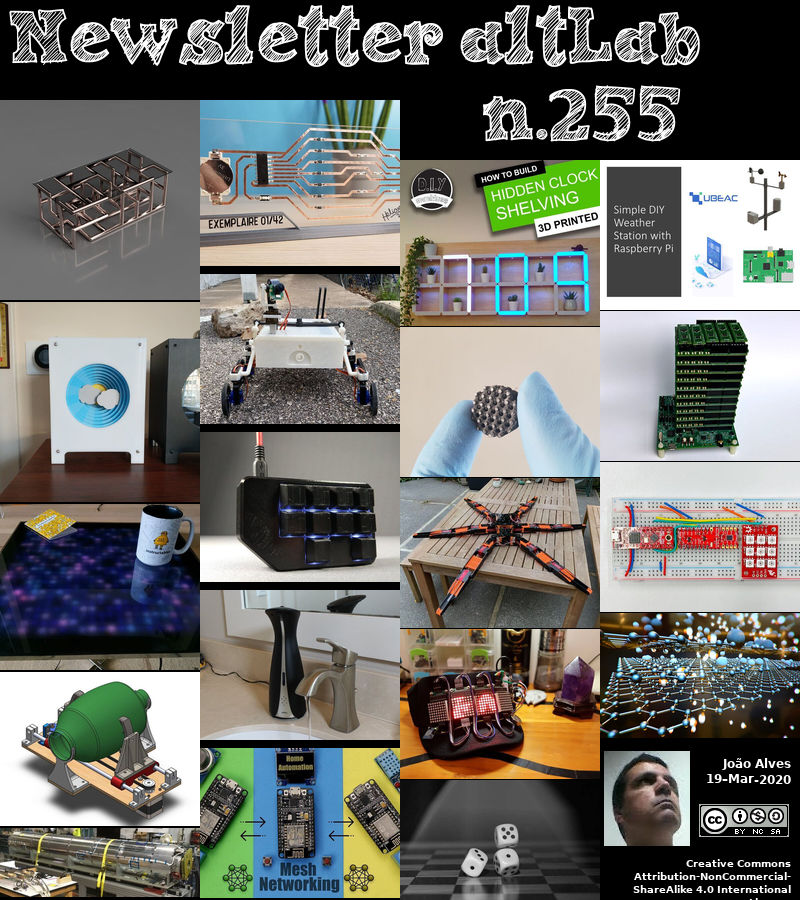2020-03-19 - Nº 255
Editorial
Esta é a Newsletter Nº 255 que se apresenta com o mesmo formato que as anteriores. Se gostar da Newsletter partilhe-a!
Todas as Newsletters encontram-se indexadas no link.
Esta Newsletter tem os seguintes tópicos:
Faz hoje anos que nascia, em 1883, o químico inglês Norman Haworth. Ele partilhou (com o químico suíço Paul Karrer) o Prémio Nobel de Química de 1937 pelo seu trabalho na determinação das estruturas químicas de vários carbo-hidratos e na síntese de vitamina C (1934), que foi a primeira preparação artificial de qualquer vitamina.
Faz também hoje anos que nascia, em 1900, o físico francês Frédéric Joliot-Curie. Ele tornou-se assistente pessoal de Marie Curie no Radium Institute, Paris, e no ano seguinte casou-se com sua filha Irène (que também era assistente do instituto). Mais tarde, eles colaboraram na pesquisa e partilharam o Prémio Nobel de Química de 1935 "em reconhecimento à síntese de novos elementos radioactivos". Por exemplo, eles descobriram que átomos de alumínio expostos a raios alfa se transmutavam em átomos de fósforo radioactivo.
Por fim, faz hoje anos que nascia, em 1943, o químico mexico-americano Mario Molina. Ele partilhou o Prémio Nobel da Química de 1995, juntamente com os químicos F. Sherwood Rowland e Paul Crutzen, por pesquisas na década de 1970 sobre a decomposição da camada de ozono, que protege a Terra de perigosas radiações solares. As descobertas de Molina e Rowland, de que alguns gases fabricados industrialmente destroem a camada de ozono, levaram a um movimento internacional no final do século 20 para limitar o uso generalizado de gases clorofluorocarbonetos (CFC).
Nesta semana que passou continuamos a acompanhar a evolução da pandemia do COVID-19. E de entre as história da semana aparece uma de uma empresa de impressoras 3D na Itália que projectou e imprimiu 100 válvulas de respiração que salvam vidas em 24 horas para um hospital que ficou sem elas. A válvula conecta pacientes em terapia intensiva a aparelhos respiratórios. O hospital, em Brescia, tinha 250 pacientes com coronavírus em terapia intensiva e as válvulas foram projectadas para serem usadas por no máximo oito horas por vez.
Também esta semana nos chega outra história relacionada, esta do Prusa - criador da impressora 3D open source. Ele fala das opções que a comunidade de impressão 3D pode criar e que já criou como vimos a história anterior para resolver problemas de produção de dispositivos que se encontram em falta por ruptura de stock. Ele fala igualmente do trabalho que ele e a equipa dele teve junto das autoridades da Republica Checa para criar o "awareness" e a necessidade de ter este tipo de fabrico como opção válida.
Na Newsletter desta semana apresentamos diversos projetos de maker assim como alguns modelos 3D que poderão ser úteis. São apresentados os livros "Essential Raspberry Pi Tips" e "Introduction to Circuits" ambos da element14.
 João Alves ([email protected])
João Alves ([email protected])
O conteúdo da Newsletter encontra-se sob a licença  Creative Commons Attribution-NonCommercial-ShareAlike 4.0 International License.
Creative Commons Attribution-NonCommercial-ShareAlike 4.0 International License.
Novidades da Semana

Coronavirus: 3D printers save hospital with valves
"A 3D-printer company in Italy has designed and printed 100 life-saving respirator valves in 24 hours for a hospital that had run out of them. The valve connects patients in intensive care to breathing machines. The hospital, in Brescia, had 250 coronavirus patients in intensive care and the valves are designed to be used for a maximum of eight hours at a time. The 3D-printed version cost less than €1 (90p) each to produce and the prototype took three hours to design. Italian journalist Nunzia Vallini put the hospital in touch with Isinnova chief executive Cristian Fracassi after discovering the original supplier was unable to supply new valves quickly. He and mechanical engineer Alessandro Romaioli raced there to see the valve for themselves - and three hours later, returned with a prototype." [...]
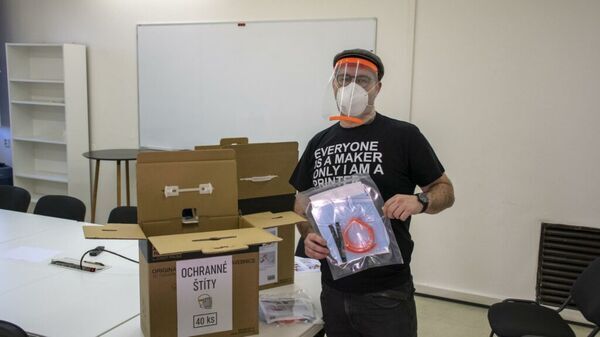
From Design to Mass 3D printing of Medical Shields in Three Days
"Hello everyone, times are tough so I will keep this short and to the point. The 3D printing community is amazing! We are all problem solvers and enjoy building things not only for our lives but also for others. In the past few weeks, we have received many messages with respirator designs, medical ventilators and other devices (that are missing in hospital’s warehouses right now) – you are looking for ways to help with this global pandemic and that’s a great thing. The worldwide demand for these devices is so huge, that in some countries, even doctors don’t have access to masks and face shields, so they have to undertake a huge risk and work without protective equipment. I am extremely proud of the whole 3D printing community and want you all to keep going!" [...]
Outras Notícias

How a Computer Chip Can Smell without a Nose
"Nabil Imam, a senior research scientist in Intel Labs’ neuromorphic computing group, works with olfactory neurophysiologists at Cornell University. “My friends at Cornell study the biological olfactory system in animals and measure the electrical activity in their brains as they smell odors,” explains Imam, who has a doctorate in neuromorphic computing. “On the basis of these circuit diagrams and electrical pulses, we derived a set of algorithms and configured them on neuromorphic silicon, specifically our Loihi test chip.” Loihi is Intel’s neuromorphic computing chip that applies the principles of computation found in biological brains to computer architectures. First, how we smell: If you pick up a grapefruit and take a whiff, that fruit’s molecules stimulate olfactory cells in your nose (the word olfactory originates from Latin’s olfactare, which means “to smell”). The cells in your nose immediately send signals to your brain’s olfactory system where electrical pulses within an interconnected group of neurons generate a smell’s sensation. Whether you’re smelling a grapefruit, a rose or a noxious gas, networks of neurons in your brain create sensations specific to the object." [...]

STMicroelectronics Launches Smart Gateway Platform for Automotive Gateway and Domain Controller Applications
"The Smart Gateway Platform (SGP) from STMicroelectronics provides a valuable development tool for prototyping automotive Smart-Gateway and Domain-Controller applications. The evolution of automotive architectures to include high throughput in-vehicle networking and high data-rate connectivity to the cloud has increased demand for high-performance Smart-Gateway and Domain-Controller Electronic Control Units (ECUs). ST’s modular Smart-Gateway Platform (SGP), built on gigabit Ethernet communication between the secure and ASIL-B Telemaco3P microprocessor (MPU) and the ASIL-D SPC58/Chorus microcontroller (MCU), delivers powerful processing capability to handle firewall functionalities, predictive maintenance, Over-The-Air (OTA) upgrades, and high data-rate communication among different ECUs and to the cloud. While the Chorus MCU provides real-time, low-power, and secure in-vehicle connectivity through its multiple CAN-FD interfaces, the Telemaco3P MPU extends gateway computational capabilities by delivering dual Arm® Cortex® A7 processing power with the Posix OS support and embedded Security Module to handle OTA updates, firewall, and predictive-maintenance functions. The SGP reference design features a rich set of in-vehicle network interfaces including multiple Ethernet and CAN ports as well as support for LIN and FlexRay connections. It is deployed with a comprehensive starter package including hardware design files, hardware/software documentation, software utilities (drivers and flashers), and sample applications." [...]

Samsung Begins Mass Production of the Fastest Storage for Flagship Smartphones
"The new 512GB eUFS 3.1 stores 8K videos and large-size image files without buffering Samsung Electronics, the world leader in advanced memory technology, today announced that it has begun mass producing the industry’s first 512-gigabyte (GB) eUFS (embedded Universal Flash Storage) 3.1 for use in flagship smartphones. Delivering three times the write speed of the previous 512GB eUFS 3.0 mobile memory, Samsung’s new eUFS 3.1 breaks the 1GB/s performance threshold in smartphone storage. “With our introduction of the fastest mobile storage, smartphone users will no longer have to worry about the bottleneck they face with conventional storage cards,” said Cheol Choi, executive vice president of Memory Sales & Marketing at Samsung Electronics. “The new eUFS 3.1 reflects our continuing commitment to supporting the rapidly increasing demands from global smartphone makers this year.” At a sequential write speed of over 1,200MB/s, Samsung 512GB eUFS 3.1 boasts more than twice the speed of a SATA-based PC (540MB/s) and over ten times the speed of a UHS-I microSD card (90MB/s). This means consumers can enjoy the speed of an ultra-slim notebook when storing massive files like 8K videos or several hundred large-size photos in their smartphones, without any buffering. Transferring contents from an old phone to a new device will also require considerably less time." [...]

Unveiling New Details of PlayStation 5: Hardware Technical Specs
"We know that fans are excited to find out more about our next-generation console, PlayStation 5, and exactly how it will bring about the future of gaming. Today we’re proud to unveil more details behind the technical and hardware components that make PlayStation 5 such an innovative and powerful platform – the ultra-high-speed SSD, integrated custom I/O system, custom AMD GPU with ray tracing, and highly immersive 3D audio. With these capabilities, PS5 will allow developers to maximize their creativity, building expansive worlds and new play experiences in the games they design. This presentation from Mark Cerny, lead system architect for PS5, dives deep into the hardware system’s architecture and how we designed PS5 to benefit developers and the games they create. As Mark discussed in his presentation, PS5’s ultra-high-speed SSD and integrated custom I/O system were developed with the goal of removing barriers to play – specifically loading screens. Developers are able to stream assets into PS5 games at an incredibly fast rate, so PS5 play experiences can be seamless and dynamic, with near-instantaneous fast travel through large game worlds." [...]
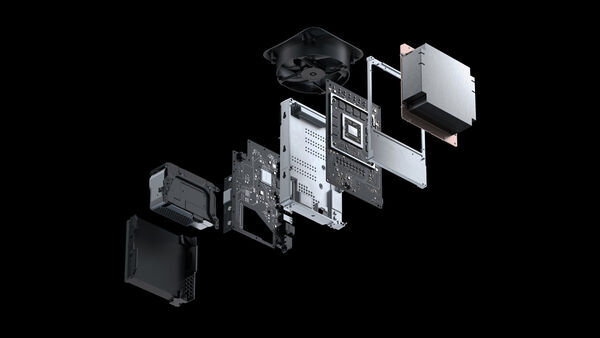
Xbox Series X: A Closer Look at the Technology Powering the Next Generation
"A few months ago, we revealed Xbox Series X, our fastest, most powerful console ever, designed for a console generation that has you, the player, at its center. When it is released this holiday season, Xbox Series X will set a new bar for performance, speed and compatibility, all while allowing you to bring your gaming legacy forward with you and play thousands of games from four generations. Recently, along with the tech experts Austin Evans and Digital Foundry, we had the chance to take a closer look at some of the technologies that are powering Xbox Series X and talk to the team about the choices they made when defining the next generation of gaming. We spent an entire day discussing everything from the console’s custom processor and latency solutions to backward compatibility and visual enhancements. (Editor’s Note: We’ll be using some acronyms and discussing technologies in this post without always defining them. To that end, we’ve created an Xbox Series X glossary that contains many of these terms and more." [...]
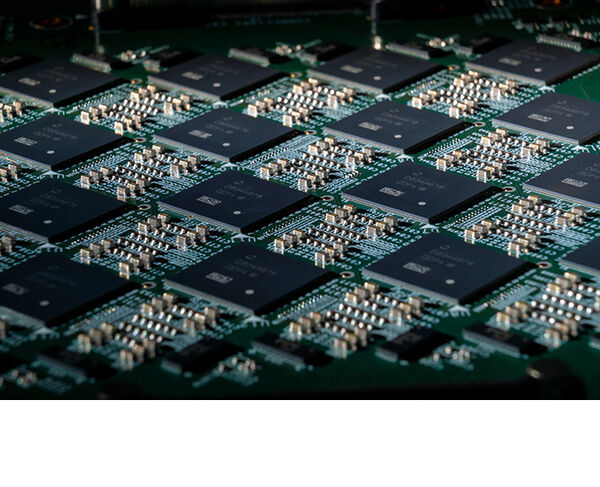
Intel Scales Neuromorphic Research System to 100 Million Neurons
"Today, Intel announced the readiness of Pohoiki Springs, its latest and most powerful neuromorphic research system providing the computational capacity of 100 million neurons. The cloud-based system will be made available to members of the Intel Neuromorphic Research Community (INRC), extending their neuromorphic work to solve larger, more complex problems. “Pohoiki Springs scales up our Loihi neuromorphic research chip by more than 750 times, while operating at a power level of under 500 watts. The system enables our research partners to explore ways to accelerate workloads that run slowly today on conventional architectures, including high-performance computing (HPC) systems.” –Mike Davies, director of Intel’s Neuromorphic Computing Lab What It is: Pohoiki Springs is a data center rack-mounted system and is Intel’s largest neuromorphic computing system developed to date. It integrates 768 Loihi neuromorphic research chips inside a chassis the size of five standard servers. Loihi processors take inspiration from the human brain." [...]
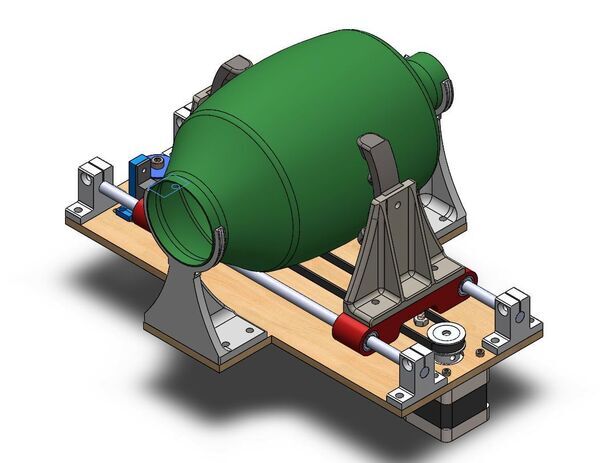
Open-source project spins up 3D-printed ventilator validation prototype in just one week
"In a great example of what can happen when smart, technically-oriented people come together in a time of need, an open-source hardware project started by a group including Irish entrepreneur Colin Keogh and Breeze Automation CEO and co-founder Gui Calavanti has produced a prototype ventilator using 3D-printed parts and readily available, inexpensive material. The ventilator prototype was designed and produced in just seven days, after the project spun up on Facebook and attracted participation from over 300 engineers, medical professionals and researchers. The prototype will now enter into a validation process by the Irish Health Services Executive (HSE), the country’s health regulatory body. This will technically only validate it for use in Ireland, which ironically looks relatively well-stocked for ventilator hardware, but it will be a key stamp of approval that could pave the way for its deployment across countries where there are shortages, including low-income nations. Ventilator hardware in the U.S. is also likely to encounter shortages, depending on the progress of coronavirus spread in the country. On Wednesday, the White House enacted the Defense Production Act, which provides broad powers to the President for redirecting materials and private company production capacity to building much-needed supplies and equipment in a time of crisis." [...]

Starlink Mission
"At 8:16 a.m. EDT, or 12:16 UTC, on Wednesday, March 18, SpaceX launched its sixth Starlink mission. Falcon 9 lifted off from Launch Complex 39A (LC-39A) at NASA’s Kennedy Space Center in Florida. Falcon 9’s first stage previously supported the Iridium-7 NEXT mission in July 2018, the SAOCOM 1A mission in October 2018, the Nusantara Satu mission in February 2019, and the second launch of Starlink in November 2019. Falcon 9’s fairing previously supported the first launch of Starlink in May 2019. You can watch a replay of launch below and learn more about the mission here. " [...]
Ciência e Tecnologia

An all-electric magnetic logic gate
"A team of researchers from ETH Zurich and the Paul Scherrer Institute has developed a way to build an all-electric magnetic logic gate. In their paper published in the journal Nature, the group describes their device and how well it works. See-Hun Yang with IBM Research–Almaden has published a News and Views piece outlining the work by the team in Switzerland in the same journal issue. Over the past several decades, computers have grown ever faster, allowing for the vast suite of advanced applications that are now available to users. In order to see similar growth in the future, new methods for building computers will have to be developed, however. This is because the physical limits of silicon microcircuitry design are approaching." [...]
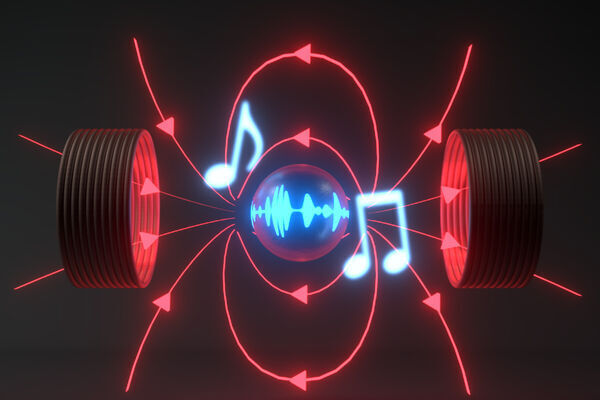
Cooling magnets with sound
"Today, most quantum experiments are carried out with the help of light, including those in nanomechanics, where tiny objects are cooled with electromagnetic waves to such an extent that they reveal quantum properties. Now, a team of physicists led by Oriol Romero-Isart at the University of Innsbruck and the Austrian Academy of Sciences is proposing to cool microparticles with sound waves instead. While quantum physics is usually concerned with the basic building blocks of light and matter, for some time scientists have now been trying to investigate the quantum properties of larger objects, thereby probing the boundary between the quantum world and everyday life. For this purpose, particles are slowed down with the help of electromagnetic waves and the motional energy is drastically reduced. Therefore, one also speaks of "motional cooling". Quantum properties occur when particles are cooled to their fundamental quantum ground state, that is to the lowest possible energy level." [...]

Getting the most energy out of the sunlight
"It´s a pity – most photocatalysts have an absorption maximum outside the sunlight spectrum. But now scientists from the e-conversion cluster were able to significantly increase the energy yield by using nanophotonic methods. Photocatalysis allows to chemically store the energy from sunlight directly. One example is the splitting of water into oxygen and hydrogen – the most important renewable fuel needed for fuel cells. Although the principle of photocatalysis has been known for a long time, it has only been used to a very limited extent. The conversion from one form of energy to another is not efficient enough." [...]

Tough, flexible sensor invented for wearable tech
"Researchers have utilized 3D printing and nanotechnology to create a durable, flexible sensor for wearable devices to monitor everything from vital signs to athletic performance. The new technology, developed by engineers at the University of Waterloo, combines silicone rubber with ultra-thin layers of graphene in a material ideal for making wristbands or insoles in running shoes. When that rubber material bends or moves, electrical signals are created by the highly conductive, nanoscale graphene embedded within its engineered honeycomb structure. “Silicone gives us the flexibility and durability required for biomonitoring applications, and the added, embedded graphene makes it an effective sensor,” said Ehsan Toyserkani, research director at the Multi-Scale Additive Manufacturing (MSAM) Lab at Waterloo. “It’s all together in a single part.” Fabricating a silicone rubber structure with such complex internal features is only possible using state-of-the-art 3D printing – also known as additive manufacturing - equipment and processes. The rubber-graphene material is extremely flexible and durable in addition to highly conductive." [...]

Proposed optical terahertz transistor
"Researchers at the Center for Theoretical Physics of Complex Systems (PCS), within the Institute for Basic Science (IBS, South Korea) have proposed a transistor made of graphene and a two-dimensional superconductor that amplifies terahertz (THz) signals. This research was conducted in collaboration with colleagues from the Micro/Nano Fabrication Laboratory Microsystem and Terahertz Research Center (China), the A. V. Rzhanov Institute of Semiconductor Physics (Russia), and Loughborough University (UK) and was published in Physical Review Letters. The growing interest in the THz frequency range can be easily explained by its various potential applications. This region of the electromagnetic spectrum, between radio waves and infrared light, is suited for extremely high-resolution images, non-invasive tumor detection, biosecurity, telecommunications, and encryption-decryption procedures, among others. However, practically, finding a powerful source of rays in this frequency range is so challenging, that researchers commonly refer to this problem as the “Terahertz gap.” In this work, the researchers proposed a novel strategy to amplify THz radiation from weak and non-uniform signals, which are common in, for instance, biological samples. The device consists of a graphene sheet positioned in the vicinity of a two-dimensional superconductor and is connected to a power source, which provides enough energy to excite the electrons of the superconductor." [...]
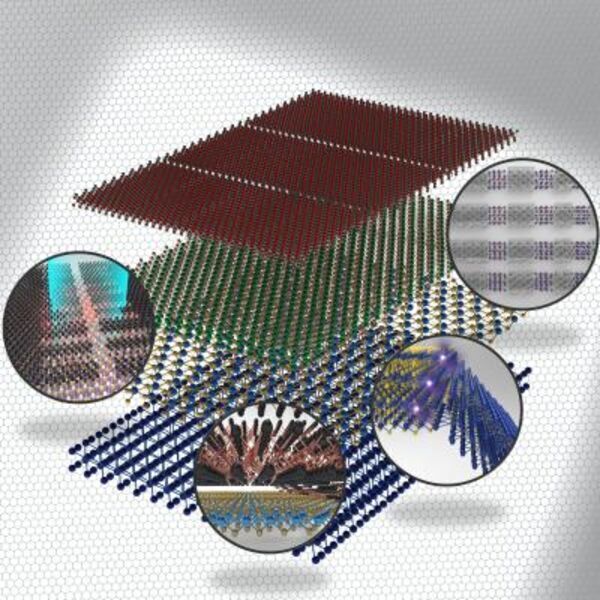
Comprehensive review of heterogeneously integrated 2D materials
"In a paper published in NANO, a group of researchers from Sungkyunkwan University, South Korea provide a comprehensive review of heterogeneously integrated two dimensional (2D) materials from an extensive library of atomic 2D materials with selectable material properties to open up fascinating possibilities for the design of functional novel devices. Since the discovery of Graphene by Andre Geim and Konstantin Novoselov, 2D materials, e.g., graphene, black phosphorous (BP), transition metal dichalcogenides (TMDCs), and hexagonal boron nitride (h-BN) have attracted extensive attention due to their broad physical properties and wide range of applications to electronic and optoelectronic devices. Research on these 2D materials has matured to the point where an extensive library of atomically thin 2D materials with selectable material properties has been created and continues to grow. By combining or stacking these 2D materials, it is possible to construct 2D heterostructures, which are built by directly stacking individual monolayers comprising different materials. Each monolayer within a 2D heterostructure is highly stable, due to strong covalent bonds between the atoms within that monolayer. However, the forces between the monolayers that keep said monolayers stacked one above the other to form the 2D heterostructure happen to be relatively weak van der Waals interactions." [...]

UCLA-led research team produces most accurate 3D images of '2D materials'
"Scientists develop innovative technique to pinpoint coordinates of single atoms A UCLA-led research team has produced in unprecedented detail experimental three-dimensional maps of the atoms in a so-called 2D material — matter that isn’t truly two-dimensional but is nearly flat because it’s arranged in extremely thin layers, no more than a few atoms thick. Although 2D-materials–based technologies have not yet been widely used in commercial applications, the materials have been the subject of considerable research interest. In the future, they could be the basis for semiconductors in ever smaller electronics, quantum computer components, more-efficient batteries, or filters capable of extracting freshwater from saltwater. The promise of 2D materials comes from certain properties that differ from how the same elements or compounds behave when they appear in greater quantities. Those unique characteristics are influenced by quantum effects — phenomena occurring at extremely small scales that are fundamentally different from the classical physics seen at larger scales. For instance, when carbon is arranged in an atomically thin layer to form 2D graphene, it is stronger than steel, conducts heat better than any other known material, and has almost zero electrical resistance." [...]
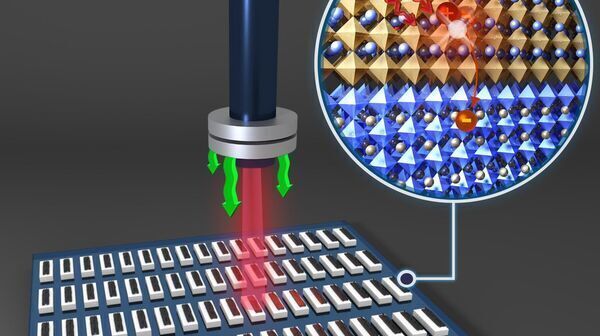
Introducing the light-operated hard drives of tomorrow
"What do you get when you place a thin film of perovkite material used in solar cells on top of a magnetic substrate? More efficient hard drive technology. EPFL physicist László Forró and his team pave the way for the future of data storage. “The key was to get the technology to work at room temperature,” explains László Forró, EPFL physicist. “We had already known that it was possible to rewrite magnetic spin using light, but you’d have to cool the apparatus to – 180 degrees Celsius.” Forró, along with his colleagues Bálint Náfrádi and Endre Horváth, succeeded at tuning one ferromagnet at room temperature with visible light, a proof of concept that establishes the foundations of a new generation of hard drives that will be physically smaller, faster, and cheaper, requiring less energy compared to today’s commercial hard drives. The results are published in PNAS." [...]

Wetting property of Li metal with graphite
""Rock-chair" Li-ion battery (LIB) was discovered in the late 1970s and commercialized in 1991 by Sony, which has become the priority way we store portable energy today. To honor the contribution for "creating a rechargeable world", the 2019 Nobel Prize in chemistry was awarded to three famous scientists (John B. Goodenough, M. Stanley Whittingham, Akira Yoshino) who made the most important contributions to the discovery of LIBs. However, this technology is nearing its practical performance limits and extensive efforts are underway to replace LIBs with new electrochemical storage solutions, which are safe, stable, low cost and with higher energy density to power long-range electric vehicles and long-lasting portable electronics. Replacing the traditional graphite-based anodes with Li metal, a "holy" anode with a high theoretical capacity of 3860 mAh/g, shows it a promising approach. At present, Li metal anode suffers from poor cycling efficiency and infinite volume change, raising operational safety concerns. Effective efforts include functional electrolyte additive, artificial solid-electrolyte interface and using host scaffolds to buffer the volume expansion have been taken to tackle its disadvantages." [...]

A Future Sound “Computer”?
"USC researchers create smart materials that can mimic electrical devices by triggering different responses to sound. From the headphones we use to listen to our favorite songs or podcasts, to sonic camouflage employed by submarines, how we transmit and experience sound is an essential part of how we engage with our surrounding world. Acoustic metamaterials are materials designed to control, direct and manipulate soundwaves as they pass through different mediums. As such, they can be designed and inserted into a structure to dampen or transmit sound. The problem is, traditional acoustic metamaterials have complex geometries. Often made of metal or hard plastic, once they are created, they cannot be changed." [...]

New carbon membrane generates a hundred times more power
"Leiden chemists have created a new ultrathin membrane only one molecule thick. The membrane can produce a hundred times more power from seawater than the best membranes used today. The researchers have published their findings in Nature Nanotechnology. Thin and porous When fresh and saltwater meet, an exchange of salt and other particles takes place. A membrane placed in water is able to harness energy from particles moving from one side to the other. A similar process can also be used to desalinate seawater." [...]
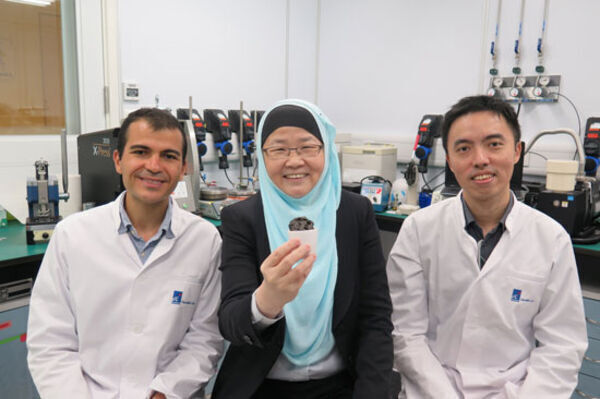
Safer high-performing batteries with NanoBio Lab’s ‘cupcake’ electrolyte
"Researchers from A*STAR’s NanoBio Lab (NBL) have designed a semi-solid electrolyte for lithium-sulfur batteries that improves their safety without compromising their performance. [1] This promising breakthrough paves the way for lithium-sulfur batteries to be used as efficient power solutions across diverse electronic and energy storage applications. Safety is an important issue hindering the use of lithium batteries by industry, due to their highly flammable liquid organic electrolytes that leak easily, and their reliance on thermally and mechanically unstable electrode separators. While solid-state electrolytes have shown potential for improving the safety profile of lithium batteries, their poor electrode/electrolyte contact and limited ionic conductivity have resulted in major conductivity bottlenecks and low performance. Prof. Jackie Y. Ying, who heads the NBL research team shared, “Hybrid quasi-solid electrolytes comprising both liquid and solid components have emerged as a practical compromise to obtain safer batteries while maintaining good performance. However, the high resistance of the solid component has thus far limited the performance of such batteries." [...]
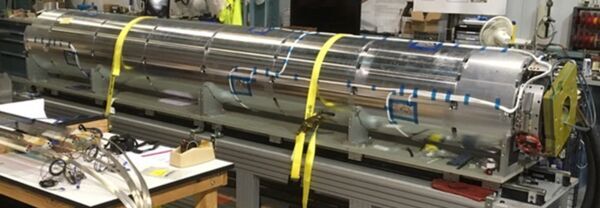
Three national laboratories achieve record magnetic field for accelerator focusing magnet
"In a multiyear effort involving three national laboratories from across the United States, researchers have successfully built and tested a powerful new magnet based on an advanced superconducting material. The eight-ton device — about as long as a semi-truck trailer — set a record for the highest field strength ever recorded for an accelerator focusing magnet and raises the standard for magnets operating in high-energy particle colliders. The Department of Energy’s Fermilab, Brookhaven National Laboratory and Lawrence Berkeley National Laboratory designed, built and tested the new magnet, one of 16 they will provide for operation in the High-Luminosity Large Hadron Collider at CERN laboratory in Europe. The 16 magnets, along with another eight produced by CERN, serve as “optics” for charged particles: They will focus beams of protons into a tiny, infinitesimal spot as they approach collision inside two different particle detectors. The ingredient that sets these U.S.-produced magnets apart is niobium-tin – a superconducting material that produces strong magnetic fields. These will be the first niobium-tin quadrupole magnets ever to operate in a particle accelerator." [...]
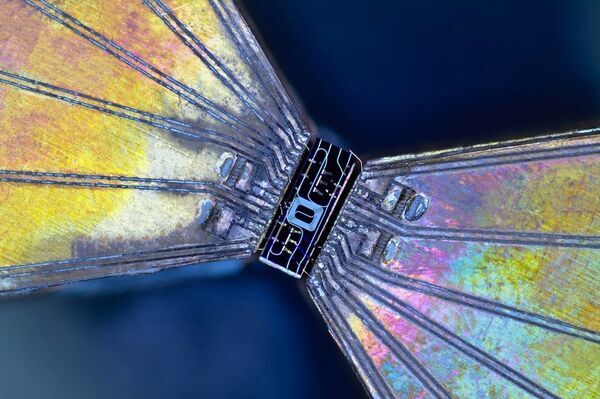
Chip-Based Devices Improve Practicality of Quantum-Secured Communication
" Researchers have demonstrated new chip-based devices that contain all the optical components necessary for quantum key distribution while increasing real-world security. The fast and cost-effective platform is poised to facilitate implementation of extremely secure data communication that can be used to protect everything from emails to online banking information. Advances in computing technology will soon leave today’s methods for encrypting online data vulnerable to eavesdropping. Quantum key distribution offers impenetrable encryption by using the quantum properties of light to generate secure random keys between users for encrypting and decrypting their online data. Although quantum key distribution is compatible with most fiber-optic networks, more robust and less expensive devices are needed to carry out this encryption method outside the lab. In Optica, The Optical Society's (OSA) journal for high-impact research, the researchers report that secure quantum key exchange can be accomplished between two chip-based devices — measuring just 6 x 2 millimeters — potentially over a fiber network with links up to 200 kilometers long." [...]

Stretchable Supercapacitors to Power Tomorrow’s Wearable Devices
"Researchers demonstrate robust supercapacitors that still work when stretched to eight times their original size Researchers at Duke University and Michigan State University have engineered a novel type of supercapacitor that remains fully functional even when stretched to eight times its original size. It does not exhibit any wear and tear from being stretched repeatedly and loses only a few percentage points of energy performance after 10,000 cycles of charging and discharging. The researchers envision the supercapacitor being part of a power-independent, stretchable, flexible electronic system for applications such as wearable electronics or biomedical devices. The results appear online March 19 in Matter, a journal from Cell Press. The research team includes senior author Changyong Cao, assistant professor of packaging, mechanical engineering and electrical and computer engineering at Michigan State University (MSU), and senior author Jeff Glass, professor of electrical and computer engineering at Duke. Their co-authors are doctoral students Yihao Zhou and Qiwei Han and research scientist Charles Parker from Duke, as well as PhD student Yunteng Cao from the Massachusetts Institutes of Technology." [...]
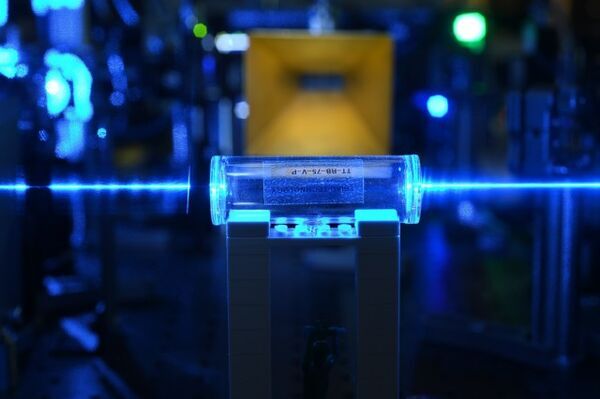
Army scientists create innovative quantum sensor
"A quantum sensor could give Soldiers a way to detect communication signals over the entire radio frequency spectrum, from 0 to 100 GHz, said researchers from the Army. Such wide spectral coverage by a single antenna is impossible with a traditional receiver system, and would require multiple systems of individual antennas, amplifiers and other components. In 2018, Army scientists were the first in the world to create a quantum receiver that uses highly excited, super-sensitive atoms--known as Rydberg atoms--to detect communications signals, said David Meyer, a scientist at the U.S. Army Combat Capabilities Development Command’s Army Research Laboratory. The researchers calculated the receiver’s channel capacity, or rate of data transmission, based on fundamental principles, and then achieved that performance experimentally in their lab--improving on other groups’ results by orders of magnitude, Meyer said. “These new sensors can be very small and virtually undetectable, giving Soldiers a disruptive advantage,” Meyer said. “Rydberg-atom based sensors have only recently been considered for general electric field sensing applications, including as a communications receiver." [...]

Pool Fire Testing Moves Composite Metal Foams Closer To Widespread Applications
"North Carolina State University researchers have demonstrated that composite metal foams (CMFs) can pass so-called “simulated pool fire testing” with flying colors, moving the material closer to use in applications such as packaging and transportation of hazardous materials. In addition, researchers used this experimental data to develop a model for predicting how variations in the CMF would affect its performance. Simulated pool fire testing is not a computational simulation. It’s an experimental test that materials must pass in order to be considered for use in manufacturing rail tank cars that transport hazardous materials. In simulated pool fire testing, a panel of material is exposed to a temperature of at least 816 degrees Celsius on one side for 100 minutes. A suite of thermal sensors rests on the other side of the panel." [...]
Semiconductors can behave like Metals and Superconductors
"The crystal structure at the surface of semiconductor materials can make them behave like metals and even like superconductors, a joint Swansea/Rostock research team has shown. The discovery potentially opens the door to advances like more energy-efficient electronic devices. Semiconductors are the active parts of transistors, integrated circuits, sensors, and LEDs. These materials, mostly based on silicon, are at the heart of today’s electronics industry. We use their products almost continuously, in modern TV sets, in computers, as illumination elements, and of course as mobile phones. Metals, on the other hand, wire the active electronic components and are the framework for the devices." [...]

Fish scales could make wearable electronics more sustainable
"Flexible temporary electronic displays may one day make it possible to sport a glowing tattoo or check a reading, like that of a stopwatch, directly on the skin. In its current form, however, this technology generally depends on plastic. New research in ACS Nano describes a way to make these displays, which would likely be discarded after a single use, more environmentally friendly using a plentiful and biodegradable resource: fish scales. Within such displays, electricity-conducting and light-emitting components are layered onto a transparent film. To make them flexible enough to withstand the bending required to stay on skin or other soft surfaces, researchers have so far relied on films made of plastic — a substance derived from fossil fuels, a limited resource and a source of pollution. Hai-Dong Yu, Juqing Liu, Wei Huang and colleagues wanted to find a more sustainable and environmentally friendly material for the film." [...]

Mathematicians develop new theory to explain real-world randomness
"Einstein’s theory of Brownian motion, which describes the random movement of particles in fluids, is widely used to model randomness throughout science. However, this revolutionary model only works when a fluid is static, or at equilibrium. In real-life environments, fluids often contain particles that move by themselves, such as tiny swimming microorganisms. These self-propelled swimmers can cause movement or stirring in the fluid, which drives it away from equilibrium. Experiments have shown that non-moving ‘passive’ particles can exhibit strange, loopy motions when interacting with ‘active’ fluids containing swimmers. Such movements do not fit with the conventional particle behaviours described by Brownian motion and so far, scientists have struggled to explain how such large-scale chaotic movements result from microscopic interactions between individual particles." [...]
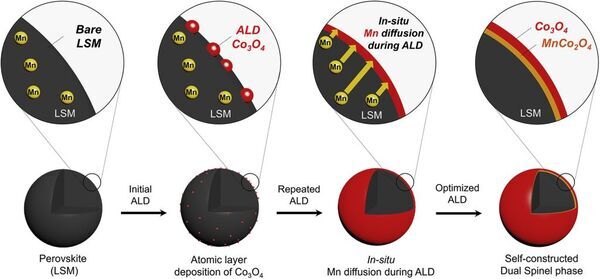
New Catalyst Provides Boost to Next-generation EV Batteries
"Metal-Air Batteries (MABs), which use oxygen from ambient air as recourses to store and convert energy, have received considerable attention for their potential use in electric vehicles (EVs) owing to their large storage capacity, lightweight, and affordability. A research team, affiliated with UNIST has announced that a new catalyst that could boost MAB performance, such as discharge and charge efficiency, was developed recently. A research team, led by Professor Guntae Kim in the School of Energy and Chemical Engineering at UNIST, has unveiled a new composite catalyst that could efficiently enhance the charg-discharge performances when applied to MABs. It is a form of very thin layer of metal oxide films deposited on a surface of perovskite catalysts, and thus the interface naturally formed between the two catalysts enhances the overall performance and stability of the new catalyst. Metal-air batteries (MABs), in which oxygen from the atmosphere reacts with metals to generate electricity, are one of the lightest and most compact types of batteries. They are equipped with anodes made up of pure metals (i.e." [...]

Machine Learning To Scale Up The Quantum Computer
"A machine learning framework has been created to precisely locate atom-sized quantum bits in silicon – a crucial step for building a large-scale silicon quantum computer Quantum computers are expected to offer tremendous computational power for complex problems –currently intractable even on supercomputers – in the areas of drug design, data science, astronomy and materials chemistry among others. The high technological and strategic stakes mean major technology companies as well as ambitious start-ups and government-funded research centres are all in the race to build the world’s first universal quantum computer. BUILDING A QUANTUM COMPUTER In contrast to today’s classical computers, where information is encoded in bits (0 or 1), quantum computers process information stored in quantum bits (qubits). These are hosted by quantum mechanical objects like electrons, the negatively charged particles of an atom. Quantum states can also be binary and can be put in one of two possibilities, or effectively both at the same time – known as quantum superposition – offering an exponentially larger computational space with an increasing number of qubits. This unique data crunching power is further boosted by entanglement, another magical property of quantum mechanics where the state of one qubit is able to dictate the state of another qubit without any physical connection, making them all 1’s for example." [...]
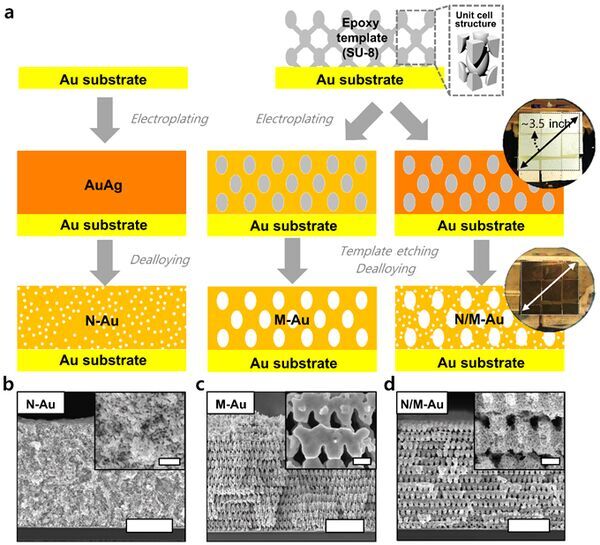
3D Hierarchically Porous Nanostructured Catalyst Helps Efficiently Reduce CO2
"KAIST researchers developed a three-dimensional (3D) hierarchically porous nanostructured catalyst with carbon dioxide (CO2) to carbon monoxide (CO) conversion rate up to 3.96 times higher than that of conventional nanoporous gold catalysts. This new catalyst helps overcome the existing limitations of the mass transport that has been a major cause of decreases in the CO2 conversion rate, holding a strong promise for the large-scale and cost-effective electrochemical conversion of CO2 into useful chemicals. As CO2 emissions increase and fossil fuels deplete globally, reducing and converting CO2 to clean energy electrochemically has attracted a great deal of attention as a promising technology. Especially due to the fact that the CO2 reduction reaction occurs competitively with hydrogen evolution reactions (HER) at similar redox potentials, the development of an efficient electrocatalyst for selective and robust CO2 reduction reactions has remained a key technological issue. Gold (Au) is one of the most commonly used catalysts in CO2 reduction reactions, but the high cost and scarcity of Au pose obstacles for mass commercial applications. The development of nanostructures has been extensively studied as a potential approach to improving the selectivity for target products and maximizing the number of active stable sites, thus enhancing the energy efficiency." [...]

Graphene solar heating film offers new opportunity for efficient thermal energy harvesting
"Researchers at Swinburne’s Centre for Translational Atomaterials have developed a highly efficient solar absorbing film that absorbs sunlight with minimal heat loss and rapidly heats up to 83°C in an open environment. The graphene metamaterial film has great potential for use in solar thermal energy harvesting and conversion, thermophotovoltaics (directly converting heat to electricity), solar seawater desalination, wastewater treatment, light emitters and photodetectors. The researchers have developed a prototype to demonstrate the photo-thermal performance and thermal stability of the film. They have also proposed a scalable and low-cost manufacturing strategy to produce this graphene metamaterial film for practical applications. “In our previous work, we demonstrated a 90 nm graphene metamaterial heat-absorbing film,” says Professor Baohua Jia, founding Director of the Centre for Translational Atomaterials. “In this new work, we reduced the film thickness to 30 nm and improved the performance by minimising heat loss." [...]

Qubits Will Operate at Room Temperature
"Scientists from NUST MISIS (Russia) together with colleagues from Sweden, Hungary and USA found a way to manufacture stable qubits that would operate at room temperature, in contrast to the majority of existing analogues. This opens up new prospects for creating a quantum computer. Moreover, the results of the research can already be used to create high-accuracy magnetometers, biosensors and new quantum Internet technologies. The article is published in Nature Communications. Quantum bit (qubit) is the smallest data storage unit in quantum systems, analogous to a well-known ‘bit’ in classical computing processes. So far, only prototypes of a quantum computer have been created, but scientists agree that in the future such a computer will have incredible computing capabilities." [...]
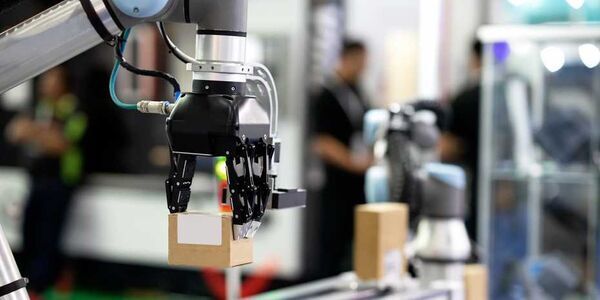
Allowing robots to feel
"With the help of machine learning, ETH researchers have developed a novel yet low-cost tactile sensor. The sensor measures force distribution at high resolution and with great accuracy, enabling robot arms to grasp sensitive or fragile objects. We humans have no problem picking up fragile or slippery objects with our hands. Our sense of touch lets us feel whether we have a firm grasp on the object or if it’s about to slip through our fingers, so we can adjust the strength of our grip accordingly. Robot gripper arms tasked with picking up objects that are fragile or slippery or have a complex surface also require this kind of feedback. Robotics researchers at ETH Zurich have now developed a tactile sensor that could come in handy in just such an instance – and marks what they see as a significant step towards “robotic skin”." [...]

Scientists Have Discovered the Origins of the Building Blocks of Life
"Rutgers researchers have discovered the origins of the protein structures responsible for metabolism: simple molecules that powered early life on Earth and serve as chemical signals that NASA could use to search for life on other planets. Their study, which predicts what the earliest proteins looked like 3.5 billion to 2.5 billion years ago, is published in the journal Proceedings of the National Academy of Sciences. The scientists retraced, like a many thousand piece puzzle, the evolution of enzymes (proteins) from the present to the deep past. The solution to the puzzle required two missing pieces, and life on Earth could not exist without them. By constructing a network connected by their roles in metabolism, this team discovered the missing pieces. “We know very little about how life started on our planet." [...]
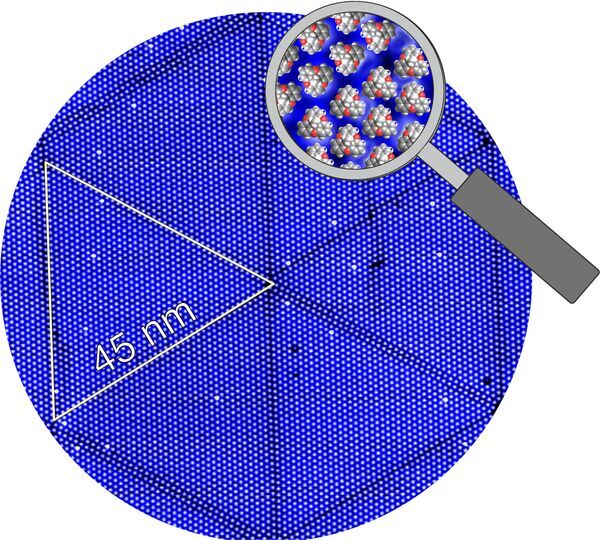
How molecules self-assemble into superstructures
"Researchers from Kiel control the size of molecular superstructures on surfaces Most technical functional units are built bit by bit according to a well-designed construction plan. The components are sequentially put in place by humans or machines. Life, however, is based on a different principle. It starts bottom-up with molecular self-assembly. The crystallization of sugar or salt are simple examples of self-assembly processes, where almost perfect crystals form from molecules that randomly move in a solution. To better understand the growth of macroscopic structures from molecules, a research team of physicists and chemists of Kiel University has mimicked such processes with custom-made molecules." [...]

A Tactile Robot Finger With No Blind Spots
"Columbia Engineers first to demonstrate a robotic finger with a highly precise sense of touch over a complex, multicurved surface Researchers at Columbia Engineering announced today that they have introduced a new type of robotic finger with a sense of touch. Their finger can localize touch with very high precision—<1mm—over a large, multicurved surface, much like its human counterpart. “There has long been a gap between stand-alone tactile sensors and fully integrated tactile fingers--tactile sensing is still far from ubiquitous in robotic manipulation,” says Matei Ciocarlie, associate professor in the departments of mechanical engineering and computer science, who led this work in collaboration with Electrical Engineering Professor Ioannis (John) Kymissis. “In this paper, we have demonstrated a multicurved robotic finger with accurate touch localization and normal force detection over complex 3D surfaces.” Current methods for building touch sensors have proven difficult to integrate into robot fingers due to multiple challenges, including difficulty in covering multicurved surfaces, high wire count, or difficulty fitting into small fingertips, thus preventing use in dexterous hands. The Columbia Engineering team took a new approach: the novel use of overlapping signals from light emitters and receivers embedded in a transparent waveguide layer that covers the functional areas of the finger. By measuring light transport between every emitter and receiver, they showed that they can obtain a very rich signal data set that changes in response to deformation of the finger due to touch." [...]

The world’s first aerogels made from scrap rubber tyres
"A team of NUS researchers has achieved a major technological breakthrough by converting waste rubber tyres into super-light aerogels that have a wide range of applications. This is the first time that aerogels are made from waste rubber tyres. The new rubber aerogels demonstrate remarkable properties — they are extremely light, highly absorbent, very durable, and they are also very efficient at trapping heat and sound. By upcycling waste rubber into products of a higher commercial value, this new technology promotes a wider use of scrap tyres, and offers an eco-friendly way to recycle used rubber. This novel technology was published in the print version of scientific journal Colloids and Surfaces A: Physicochemical and Engineering Aspects in September 2019, and a patent has been filed. To boost the research efforts of the team and raise public awareness of recycling, Mapletree Investments, a leading real estate developer with a strong focus on environmental sustainability, has recently made a gift of S$155,000 to NUS." [...]
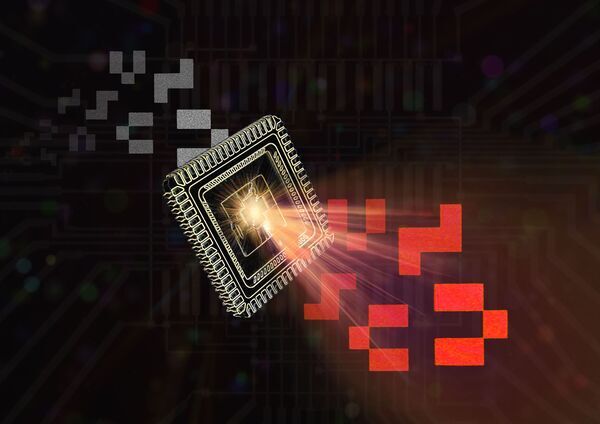
Neural Hardware for Image Recognition in Nanoseconds
"An ultra-fast image sensor with a built-in neural network has been developed at TU Wien (Vienna). It can be trained to recognize certain objects. It has now been presented in "Nature". Automatic image recognition is widely used today: There are computer programs that can reliably diagnose skin cancer, navigate self-driving cars, or control robots. Up to now, all this has been based on the evaluation of image data as delivered by normal cameras - and that is time-consuming. Especially when the number of images recorded per second is high, a large volume of data is generated that can hardly be handled." [...]

New Record Set For Cryptographic Challenge
"An international team of computer scientists has set a new record for integer factorization, one of the most important computational problems underlying the security of nearly all public-key cryptography currently used today. Public-key cryptography is used for a number of applications including encrypting sensitive and confidential data and digital signatures. In public-key cryptography, keys that protect data come in pairs, one public, and one private. The security of the encryption or digital signature relies on the assumption that it’s impossible to compute the private key from the public key. One of the most commonly used public-key cryptographic algorithms for both encryption and digital signatures is the RSA cryptosystem, invented in 1977. It’s named for its inventors Rivest, Shamir, and Adleman." [...]

A flexible brain for AI
"Scientists at Osaka University built a new computing device from field-programmable gate arrays (FPGA) that can be customized by the user for maximum efficiency in artificial intelligence applications. Compared with currently used rewireable hardware, the system increases circuit density by a factor of 12. Also, it is expected to reduce energy usage by 80%. This advance may lead to flexible artificial intelligence (AI) solutions that provide enhanced performance while consuming much less electricity. AI is becoming a part of everyday life for almost all consumers. Ridesharing smartphone apps like Uber, Gmail’s spam filters, and smart-home devices like Siri and Nest all rely on AI." [...]

Recyclable Nano-Fiber Filtered Face Masks a Boon for Supply Fiasco
"Wearing a face mask is a common sight in Korea during the COVID-19 outbreak. Due to the overwhelming demand, last week the government started to ration two masks per person per week, as a drastic measure to address the supply fiasco. The face masks most commonly used are disposable ones, originally made for filtering out up to 94 or 95 percent of fine dust, referred to as N94 or N95 masks. A KAIST research team announced that they have developed a nano-filter that maintains excellent filtering efficiency even after hand washing through the development of proprietary technology that aligns nanofibers with a diameter of 100~500 nm in orthogonal or unidirectional directions. This reusable nano-filtered face mask could help to relieve the challenges arising from the supply shortage of face masks. Professor Il-Doo Kim’s nano-fiber filtered mask will maintain its sturdy frame and filtering function even after being washed more than 20 times." [...]
Modelos 3D
Com a disponibilidade de ferramentas que permitem dar azo a nossa imaginação na criação de peças 3D e espaços como o thingiverse para as publicar, esta rubrica apresenta alguns modelos selecionados que poderão ser úteis.

Electronics Project Box with Perfboard
"I was constructing a circuit to key my amateur radio transceiver from a Raspberry Pi running fldigi. I needed a piece of perfboard and a plastic box, so I designed then using OpenSCAD. The file keyerbox17.scad is the plastic box and perfboardkeyer9.scad is the piece of perfboard with a footprint on each end for a connector and space for an audio transformer. You can easily customize the size of the box and the perfboard for your own projects. I printed both in PLA and found that I could heat up the wires going through the perfboard holes without melting the PLA if I worked quickly. The two halves of the box snap together." [...]

Corona door opener remake
"Door opener for public doors. " [...]
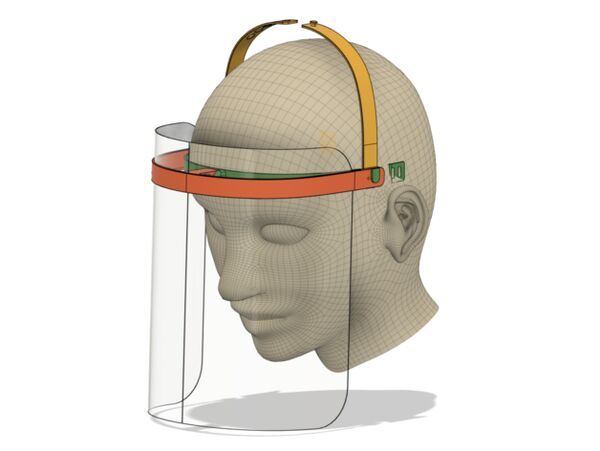
3D printed Face Mask A4 sheet
"3D printed Face Mask with clear acrylic A4 sheet. Why so many revisions? We are still working on the design. If you have trouble finding what you are looking for check the PDF for images. This model is still being revised and edited. Feel free to print it share your results and give us feedback." [...]
Documentação
A documentação é parte essencial do processo de aprendizagem e a Internet além de artigos interessantes de explorar também tem alguma documentação em formato PDF interessante de ler. Todos os links aqui apresentados são para conteúdo disponibilizado livremente pelo editor do livro.
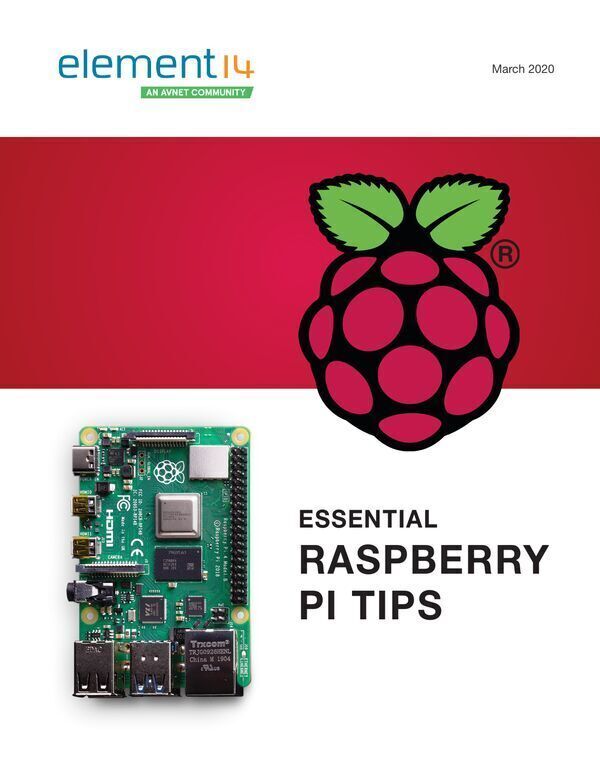
Essential Raspberry Pi Tips
"February of 2020 will mark the eighth birthday of the initial release of the Raspberry Pi 1 Model B. While the Pi is far from the first single board computer, none have enjoyed the same widespread success. Alternatives to the Pi may have faster CPU speeds, more IO, or specialized on-board peripherals, and they have their place, but none of them have that “just right” combination of price, support, power, and features. According to the Raspberry Pi blog, over 19 million Pis have been sold. This writer has been using and following the evolution of the Raspberry Pi since its release. I watched as it transitioned from a tool for students and hobbyists to a viable option for certain types of engineering projects." [...]
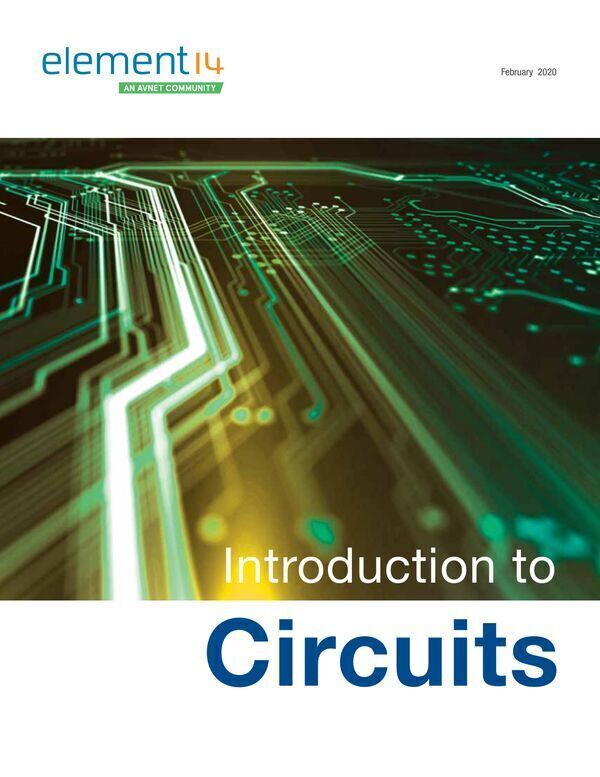
Introduction to Circuits
"We represent a Community of over 700,000 makers, professional engineers, electronics enthusiasts, and everyone in between. Since our beginnings in 2009, we’ve provided a place to discuss electronics, get help with your designs and projects, show off your skills by building and documenting a new prototype, and much more.On our Community you can find Essentials courses that delve into the details of important electronics concepts, element14 Presents video tutorials that show you a project from start to finish, Design Challenges that follow a build from concept to prototype, and more. This eBook is focused on the fundamentals of circuits and their behavior, with an illustrated guide to building your own circuits with items you can find around the house. We hope you find this guide useful and enlightening, so happy reading! " [...]
Projetos Maker
Diversos Projetos interessantes.
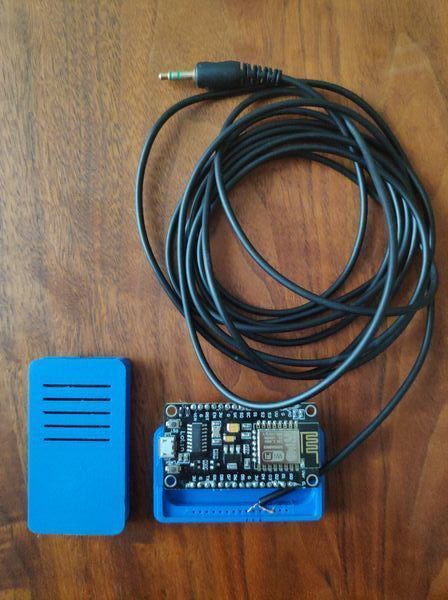
IRDenon
"Web Interface to remote control a Denon AVR with an ESP8266 and a infrared led or the Room to Room connection. There are 4 ways to remote control older Denon AVR's (in my case Denon AVR 2308): 1. by remote: my AVR is inside a tv console and there is no line of sight. 2. by RS232: i managed to remote control it by connecting the COM Port of an old PC (which still has a COM port interface) and it worked perfectly. I just did not want another PC running. My first intention was to connect the ESP8266 Serial port to the Denon COM Port but I just could not get it working. 3." [...]
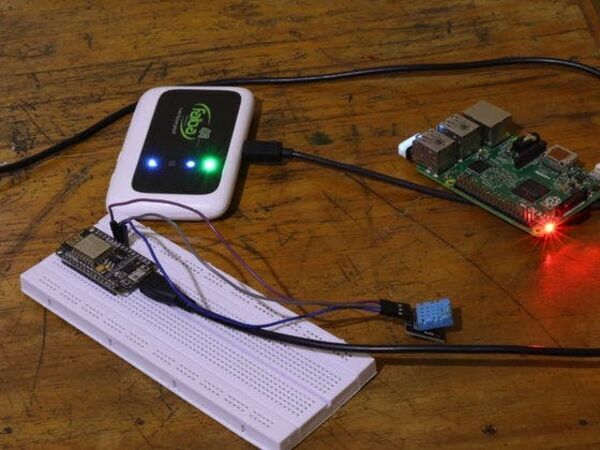
Sending Temperature and Humidity Data to the IOTA Tangle
"The project is an attempt to combine the two technologies, MAM and MQTT, to store temperature and humidity information on the IOTA Tangle. The project is an attempt to combine the two technologies, MAM and MQTT, to retrieve and store information in the blockchain. In this case the IOTA Tangle. MQTT is a Client Server publish/subscribe messaging transport protocol. It is light weight, open, simple, and designed so as to be easy to implement. These characteristics make it ideal for use in many situations, including constrained environments such as for communication in Machine to Machine (M2M) and Internet of Things (IoT) contexts where a small code footprint is required and/or network bandwidth is at a premium." [...]

Create A Web Server w/ ESP32
"In this tutorial, you’ll learn how to set up a web server with ESP32 and create a web page using HTML and CSS. What You Will Learn Getting to know the web server Creating a web server with ESP32 A short introduction to HTML and CSS commands What is a Web Server? The web server is a place to send and receive information, process the information and store it. The web server can also display this information on a web page. the server communicates with the user through a protocol called the Hypertext Transfer Protocol (HTTP). When a request is sent to this server (for example, its address is searched in the browser), the server returns a code as a response (for example, code 200, which means the connection is established correctly, or code 404, which indicates that the address is not correct)." [...]
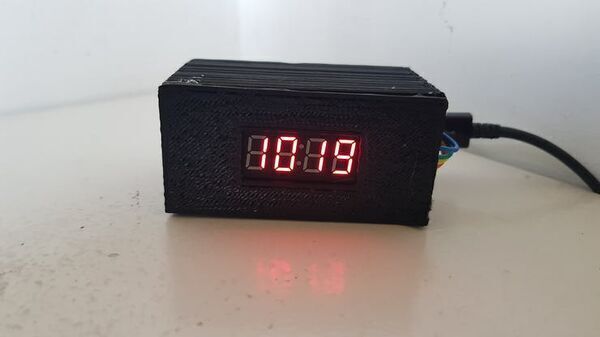
Autoadjust Desk Clock with ESP8266
"What about a 7 segment display clock for your desk with auto time adjust? Only 2 componentes and that's it So you work in your cubicle and knowing the hour is an important deal for commuting. What about a retro 7 segment clock for your desk? And can we add auto time adjustment? Sure we can and it is not complicated. " [...]

RB-0 - Jetson Nano Powered Rover
"RB-0 is a hobby sized rover that uses the same suspension concept as NASA's newer differential-bar rovers. It uses a Jetson Nano + camera. RB-0 is an educational AI robot that uses a differential bar, camera, Jetson Nano, and 15 servos. " [...]

Fortune Cookie Teller Hat
"Long story: I originally made this hat for my company's stall at Taipei International Book Exhibition, which was postponed from early February to May due to the threat of coronavirus (COVID-19). I thought it would be fun to wear a hat with bright texts (probably for ads or taglines) scrolling on it; You usually don't see such things in a traditional book fair. A few days ago, we learned that the book fair will still likely get canceled anyway. Now, since the hat had lost its intended purpose, what should I do with it? How do I salvage this project? In the end I decided to turned it into a wearable fortune (cookie) teller." [...]
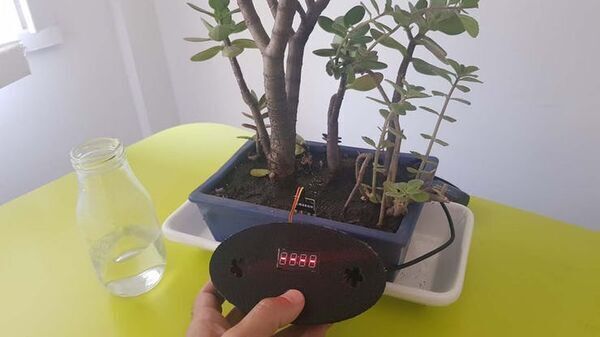
The Sound Machine (Hear Plant Mood)
"Based on Roald Dahl short story, this machine will let you "hear" plant mood according to soil moisture. Even when sounds of course do not come from the plants but from MP3 recordings, the experience results revealing and lets you be conscience about plants being alive and the suffering from water deprivation. I've used an Arduino Nano, FC28 sensor, 7 segment display, a button, a 4ohm speaker, DFPlayer MP3 player, a microSD card and a custom case. The code will check button status and when button is pressed it will read FC28 sensor, analog values will be mapped to 0-100 percentage scale, the percentage will be printed in the 7 segment display and a custom recording will be played according to the moisture percentage. For example: screams when moisture is less than 30%, giggles when moisture is greater than 75%, etc" [...]
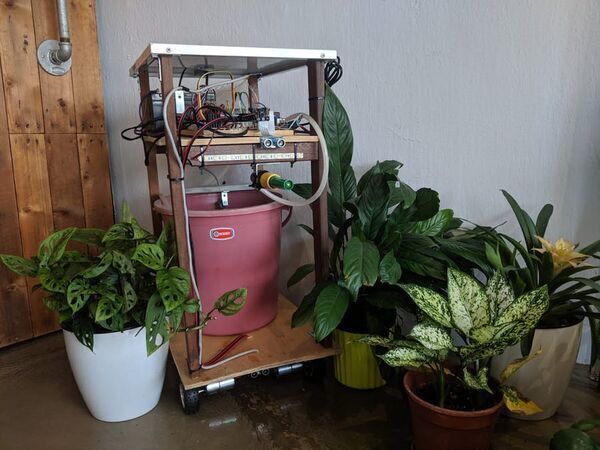
The Irrigator: AI-powered irrigation robot
"An autonomous, sustainable robot that takes care of plants. Built from scratch, the Irrigator runs TFLite object detection on Jetson Nano. The Irrigator: AI-powered irrigation robot The Irrigator is an autonomous, sustainable, smart robot that takes care of indoor and outdoor plants. This presentation focuses on watering the plants, but the design and implementation can be extended to perform other tasks such as dispensing fertilizer and pesticide, detecting the level of water in the soil, detecting sick plants. Design Broad design goals: Autonomous - it does its job with no (or minimum) human interaction. Sustainable - it uses solar energy to recharge its battery, rainwater to refill its water tank, and it's made out of recycled materials, wherever possible (e.g." [...]
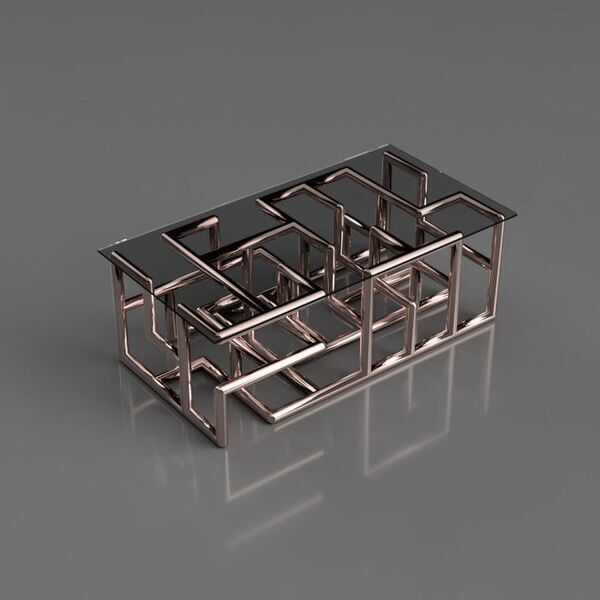
Easy Designing of Copper Pipe Industrial Style Furniture
"Making pieces of furniture with copper pipes and fittings that you can find in plumbing supplies stores is not a new idea. Their crude unfinished appearance and monochrome color marks the so-called industrial design. This style began to reach the general public more and more at the beginning of the 2000's but until today it enjoys a great popularity. There are thousands of projects on the Internet that present desk lamps, shelves, tables, candle holders, all kinds of stands, frames, other pieces of furniture, elements of artistic decoration. I have also found here on instructables some projects like this, for example: Copper Pipe Candelabra Copper Pipe Table Lamp Copper Pipe Towel Rail Copper Pipe Candlesticks Easy Copper Pipe and Reclaimed Wood Table Copper Pipe Wine Rack Copper pipe photo frames No Solder Copper Pipe Stool How to Make an IPad Holder Out of Copper Pipe As you can see there are many projects! Their practical implementation is described in extenso and I could not add any more details on this." [...]
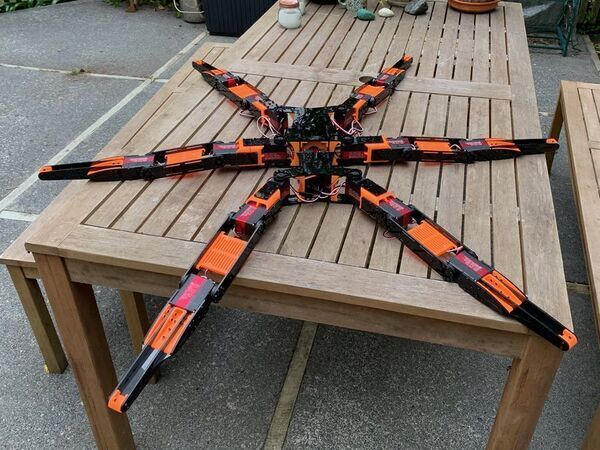
Augie the Hexapod Robot
"Imagine a hexapod big enough to ride around like an electric scooter. Oh yeah! Some time back in 2016 I started on a circuitous journey to build a hexapod robot. I had stopped working for OSH Park about a year before and was working on a more "enterprisey" client project. The project was interesting enough, but I missed mucking around with electronics. I also missed my old hobby of building (and mostly crashing) electric radio controlled helicopters, which I had abandoned when my children arrived in my life for time/cost reasons." [...]

Mini PC Keyboard
"A minimalistic PC keyboard design based on Arduino that offers a specific set of keys in order to play some online role games. Even though there are commercial products out there that can fit almost everyone's needs, it's always fun to build something custom and unique. This was a chance for me (an excuse) to design a new gadget and film the whole process. This time I uploaded every required hardware part as well and the STL files. Watch the building process if you plan to make one! Basic theory: Every Cherry MX switch is connected to a digital input pin on the Arduino Micro Pro." [...]

MQTT-Enabled Scrolling Text with ATOM Matrix and MicroPython
"Use your ATOM Matrix to receive text via MQTT and scroll it on the RGB LEDs. " [...]

Game of Life Coffee Table
"As I told you in my article "The Beauty of Math - Conway's Game of Life Art" I was thinking it would be nice to make a piece of furniture, in this case a small coffee table, that it would be an interesting and pleasant image to display the light games I proposed. It could even be a subject of discussion at a cup of coffee :) I will not particularly insist on the mathematical theory on which the light effects are displayed, I presented in that article already, but I will insist on how its done, hoping that you will realize how easy it is to build such a piece of furniture. I also think that you will notice in this article that I tried as much as possible to minimize the cost of the materials and the effort put into practical realization, which I often do in my articles because I do not like to reinvent the wheel. My opinion is that it is much faster and easier when we can call on local craftsmen who know their profession and I cannot have (in my apartment) a glass workshop, a carpentry workshop, a locksmith workshop anyway. I did not build the table because I wanted, as I said before, to make my work easier, so I ordered the coffee table online (I really like to improve the products I buy). So I chose a simple, modern, elegant with a glass top of course." [...]
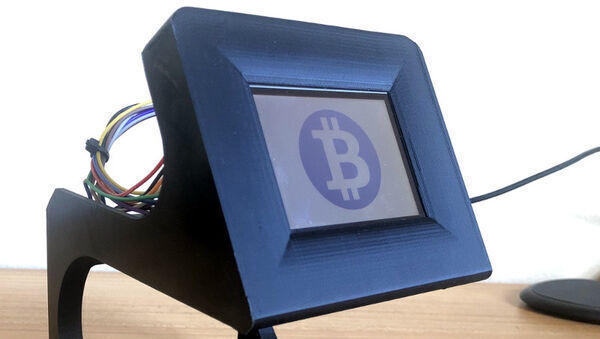
btc_faucet
"A minimal gui implementation of a bitcoin faucet that is capable of running on a Raspberry Pi Zero W (rpi). Motivation There are plenty of digital faucets but a google search at the time resulted in no physical bench top ones -- so I set out to create it. This was strictly a learning exercise and an opportunity to build something. " [...]

Arduino Vocal Effects Box
"This Arduino-powered vocal effects box pitch shifts and distorts incoming audio signals to produce a wide variety of vocal effects. This project is my first experiment with real-time digital signal processing using Arduino. It samples an incoming microphone signal at a rate of about 40kHz, manipulates the audio digitally, and then outputs 8 bit audio at 40kHz. To minimize the amount of computation required by the Arduino, I used a technique called granular synthesis to manipulate the incoming audio signal. Essentially, as audio comes into the Arduino it gets cut up and stored as small (millisecond or microsecond sized) samples called "grains." These grains are then individually manipulated and played back; they may be lengthened or shortened, stretched or compressed, played back in reverse, copied several times, or mixed with other grains." [...]
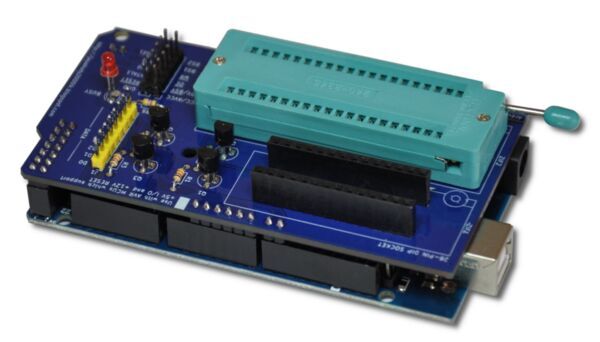
AVR High Voltage Programmer 2
"AVR-HV2 is Arduino based high voltage parallel programmer for AVR microcontrollers. This programmer can read, write, and erase both flash memory and EEPROM. Also, this can use to set fuse bits of AVR MCUs. AVR-HV2 programmer is designed as an Arduino Mega shield. Dimensions of the AVR-HV2 are similar to the Arduino Mega board. It can be powered using a power source connected to the Arduino Mega board." [...]
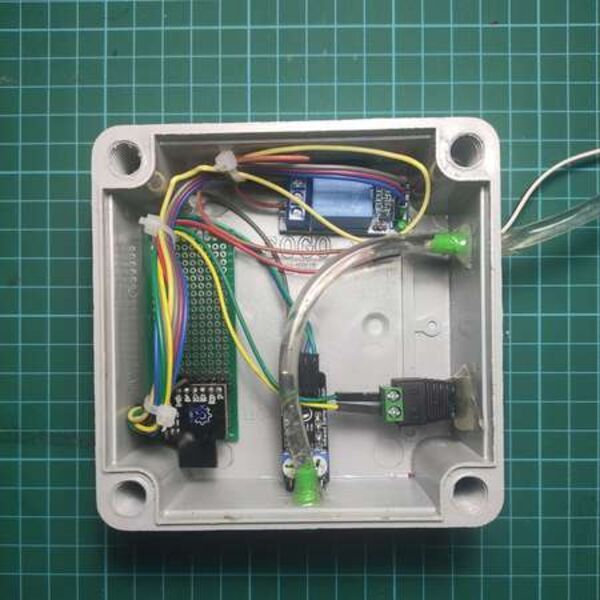
OpenDispenser
"I was asked to make a set of automatic hand-sanitizer dispensers (on a short-time notice, of course) for Barcamp Yangon 2020 Event. Amid Corona/COVID-19 virus outbreak events, event organizers took public health protection in consideration and planned to hand out face masks to attending audience and place hand sanitizer dispensing stations at a number of locations. Commercial dispensers were hard to find/buy at the moment and easier alternative would be to make it DIY. With cost efficiency and local availablity of resources/parts in consideration, we (a team of contributers) prototyped and supplied some dispensers for Barcamp Yangon 2020 event. Hardware Although a simple 555-IC timer circuit would do the job, we wanted to implement (in the future events) a function that will log how many times have it been used the dispenser throughout the event. We chose a small, simple and cheap (which you can get from Aliexpress for $2) Digispark ATtiny85 USB Dev-Board (or alternative ones) as our main controller." [...]
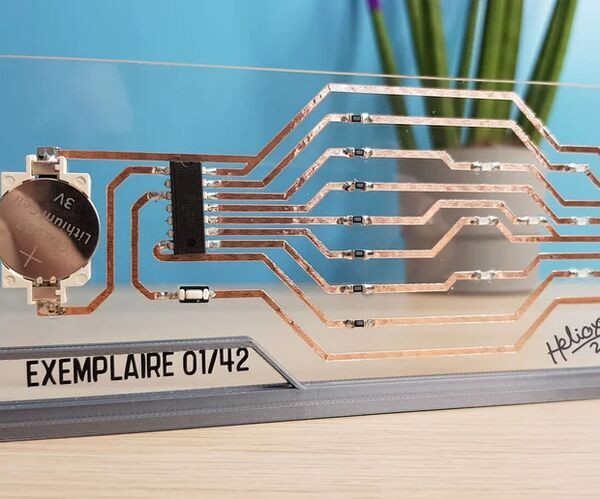
Creating Easy Glass Circuit Boards at Home
"Printed circuits boards surround our daily lives : High Tech products, computer tools, household appliance, have one or more electronic circuits. Before in tutorials, I explained the manufacture of a printed circuit at home. Today, You’ll discover the process of constuction of a PCB on glass. It’s beautiful, fun and original ! Supplies: - Silhouette cutter CAMEO 4 - Copper sheet A4 - Copper Roll - Transfer paper - ATtiny 84 - LED SMD - CMS Resistor 100Ω - Support CR2032 - Button" [...]
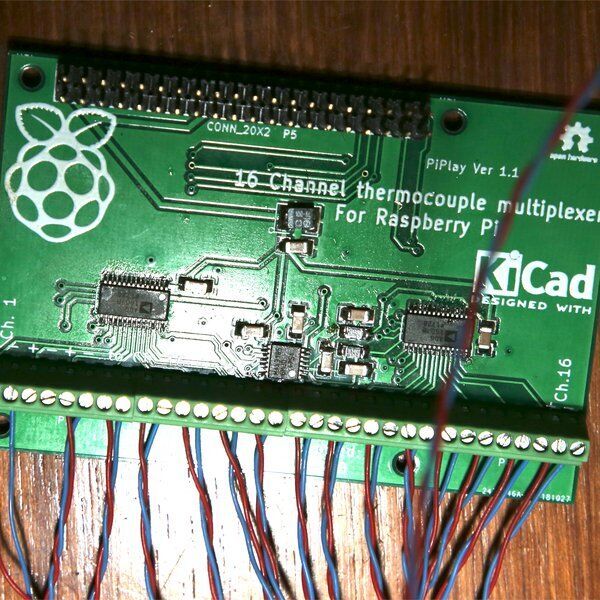
16 Channel Thermocouple Multiplexer for Raspi
"A auxiliary board capable of handling 16 thermocouples and passing their temperatures to a Raspberry Pi via SPI An SPI board which allows temperature measurement from 16 thermocouples to a Raspberry Pi. Temperature is measured using a Maxim 31856. It will handle different thermocouple types attached and a temperature range from -200 C to + 1700 C (Thermocouple Dependant) Example Python software allows the direct display to screen and periodic logging to file. This project is released under the Creative Commons Attribution licence CC-BY. This license lets others distribute, remix, tweak, and build upon our work, even commercially, as long as they credit us for the original creation. Measuring Temperature Thermocouples are thin wires of two different types." [...]

Wash Timer
"This is an easy-to-build timer to use while washing your hands which doesn't involve trying to sing a song in your head. Just wave your hand in front of it and wait for the LEDs to go off. Here are the modules I used to build it, but honestly, you could replace any of them with whatever you have in your parts box. The display could be a 7-segment display, or even a handful of LEDs instead. The proximity sensor could be replaced with an ultrasonic rangefinder, or a light-break setup but it's best to avoid a physical switch that people would have to press before washing! Display module: https://www.banggood.com/MAX7219-Dot-Matrix-Module-4-in-1-LED-Display-Module-p-1072083.html Proximity sensor: https://www.pololu.com/product/1134 Arduino: Use any Arduino or Arduino-compatible board." [...]

DIY UV Light Box Controller For SLA 3D Prints
"Just add your own enclosure, 12V adapter and UV LED strip! Make your own budget UV light box with built in adjustable timer and intensity. Easy to use UI displayed on cheap commonly available OLED screens (compatible with ssd1306, ssd1309 and sh1106) with three button interface and piezo speaker alarm. " [...]
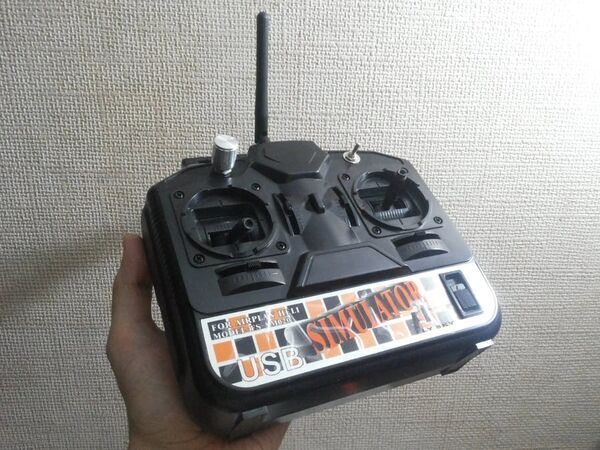
Making Arduino-Based RC Transmitter of USB Flight Simulator
"My variant of converting a four-channel USB flight simulator into an RC transmitter using Arduino. USB flight simulators are used with special computer software (e. g. FMS, Fig. 1) for training or skill maintenance. Then I defined basic functionality of the device: 2.4GHz operation frequency; power supply from 18650 Li-Ion battery providing charging from USB-adapter without removing the battery from the transmitter; battery charge control; end point adjustments and reversal for each channel; simple audible indication for each operating mode of the transmitter. After that I collected all the necessary hardware: ARDUINO Pro Mini board – «brain» of the transmitter, with small-sized (I had already had it in use); solderless breadboard – as I planned to experiment and add functionality step by step I decided not to use soldering near ARDUINO board; nRF24L01 module with external antenna for data transmitting; 5V-3.3V adapter for nRF24L01 module since the main voltage is 5V but the module requires 3.3V; piezobuzzer responsible for all sounds from the transmitter;; encoder with a switch for channel selection and adjustment; wires – both usual and ones for solderless setup; power supply system (Fig. 5) which was the first thing to make because there was no sense to continue without it." [...]
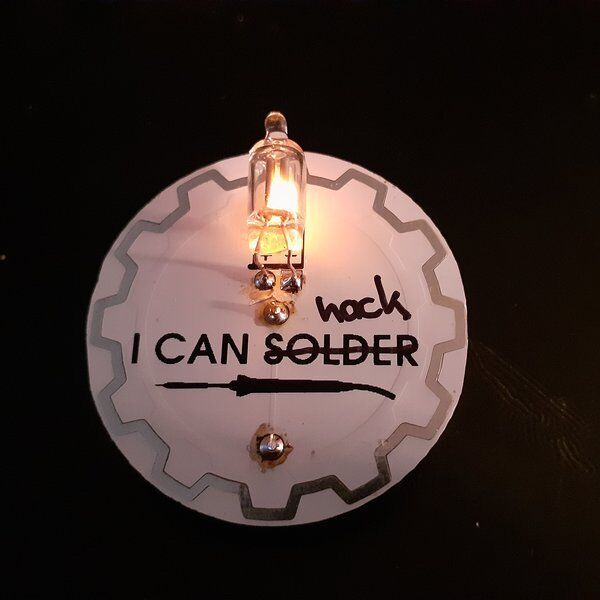
I can hack Pin
"Hacking the "I can solder" pin with a fancy steampunkish neon bulb lamp and a high voltage joule thief During the last Chaos Communication Camp during summer 2019 I got an I can solder pin. So I walked directly into the hack tent of our village, soldered the pin, the LED and the battery holder and tada! The funny little RGB LED was flickering in different colours. It was a fantastic camp and I had my 42nd birthday and so it was a great party. Some days ago I found this pin again and I was asking my self if it is possible to hack this little simple pin. I love steampunk and also tubes, brass etc." [...]

Home Automation with Mesh Networking
"Till now you have seen many different kind of Home automation using Smart phone, Blynk, Google Assistant, Alexa, Google Firebase or even local MQTT server based as well. But what if I tell you that there is one more method of controlling appliances which don’t require Internet or not even a router. Here I present you my Home Automation project made using Mesh Networking Components Required NodeMCU Board x 3 Relay Module x 2 DHT11 Sensor MQ135 Sensor OLED Display Pushbutton x 2" [...]
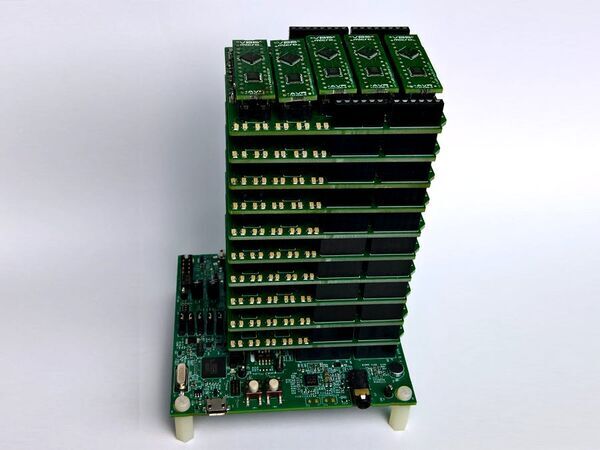
Unit Test Tower - Parallel Arduino Testing Supercomputer
"Run up to 50 parallel unit tests on 50 Arduino virtual breadboard sandboxes. Test Tower makes test driven development for Arduino possible! i.MX RT1010 EVK Based Unit Test Tower The Arduino UNO is programmed and debugged with a Serial Port over USB at 115Kbaud. But what if you want to program and control 50 Arduinos at the same time! This was the challenge I put to the i.MX RT1010. The i.MX RT1010 EVK is used to host up to 10 Test Shields each with 5 VBBMicro sandbox's to host up 50 Virtual Arduino UNOs in total." [...]

Monty Python's Argument Bot
"In need of a good argument? Try the argument bot! A robot based on Monty Python's Flying Circus argument sketch. " [...]

Interfacing Hall Effect sensor with Arduino
"Easy way to interface Hall Effect sensor to be used later for proximity sensing, speed measuring and switching This is a fast and straightway tutorial on how to interface you Hall-Effect sensor with Arduino board, here I’m using Arduino UNO as usual. So the Hall-Effect is the production of a voltage difference (the Hall voltage) across an electrical conductor, transverse to an electric current in the conductor and to an applied magnetic field perpendicular to the current.Here in the media below you can see a simple visualisation of the effect (Source: Wikipedia): This effect is exploited to detect position, speed, current and proximity sensing, today we gonna use it with a magnet, to detect the magnetic field and check the values given by the sensor. In the picture below you can see the sensor I’m using, it’s a KY-024, and as you can see that board is pretty much common, it’s used for different sensors. " [...]
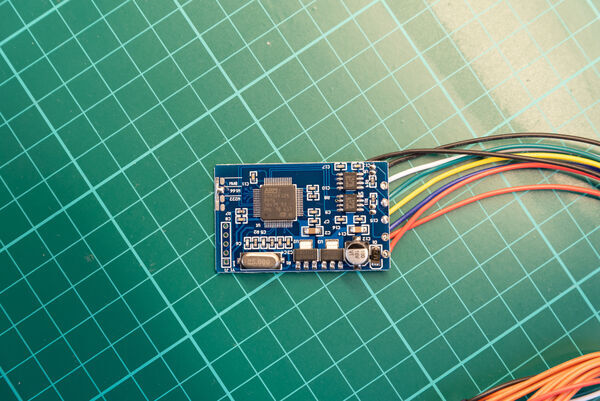
Hacking A Mileage Manipulator Can Bus Filter Device
"I have read an article on the teardown of a dashboard mileage manipulator dongle on Hackaday. A “CAN bus filter” device was found in a vehicle, connected to the back of its instrument cluster. When it was removed and the original connections were restored, the odometer immediately showed 40 000 kilometers more than before. The author made a quick teardown and analysis on the device but because it was supposed to be locked (according to the article), the firmware was not extracted, leaving the big question unanswered: What it does and how it does it? Mileage manipulation is illegal in many countries and one could easily go to jail if kept doing it. Still, this is quite common practice on the used car market and mileage manipulator devices could be easily purchased by anyone." [...]
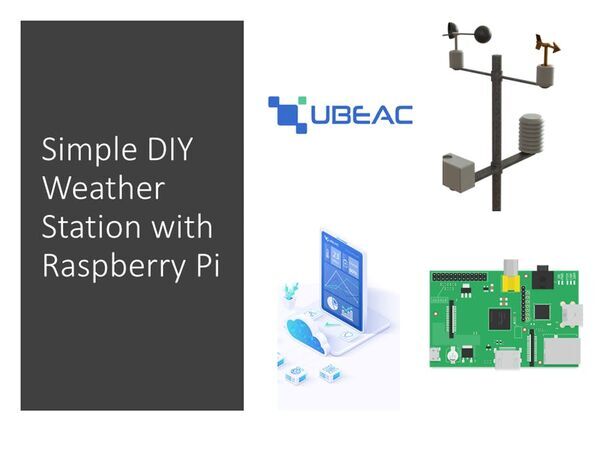
Simple DIY Weather Station w/ Raspberry Pi
"Being aware of the weather conditions around you is easy with a DIY Weather Station using Raspberry Pi. Do you ever suddenly get the chills, so you check the temperature inside your room to make sure you’re not paranoid but then realize you don’t have any way to check? Or when the weather station’s predictions just seem too good to be true, so you double check the forecast for the nearest major city which doesn't tell you anything about the weather directly around you? Well, a simple DIY Weather Station can solve both of those problems, and all you need is a Raspberry Pi, some sensors, and an easy-to-use IoT platform to make it! Once you have this project in your life, you’ll never have to worry about whether it’s the weather or you that’s cold. " [...]
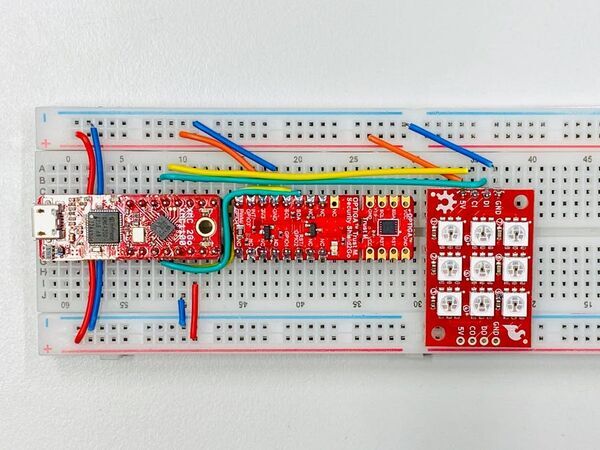
Low Power Cryptographic Dice
"Use an Optiga security chip to generate random numbers for super low power electric dice! We built low power electronic dice which only needs a power supply when showing a number. No gaming, no power consumption. " [...]
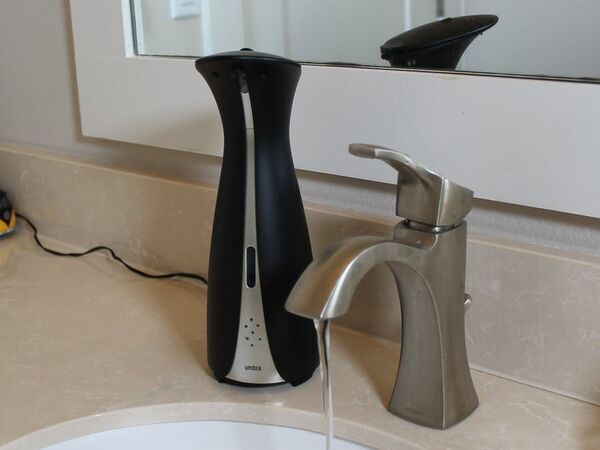
Musical Soap Dispenser
"Play your favorite tune for 20 seconds while you wash your hands. At the beginning of the COVID-19 outbreak I was given this handy automatic soap dispenser. With everyone coming up with different songs to sing while you wash your hands, I thought, there has to be a better way. I am a not a great singer and would rather hear the bands I love than try to match my voice to the Killers. It’s a hacked Umbra Automatic Soap Dispenser with a speaker, MP3 circuit and micro controller. The Dispenser takes a microSD card with your favorite songs on it, each song is edited down to the chorus, playing 20 seconds while you wash your hands." [...]
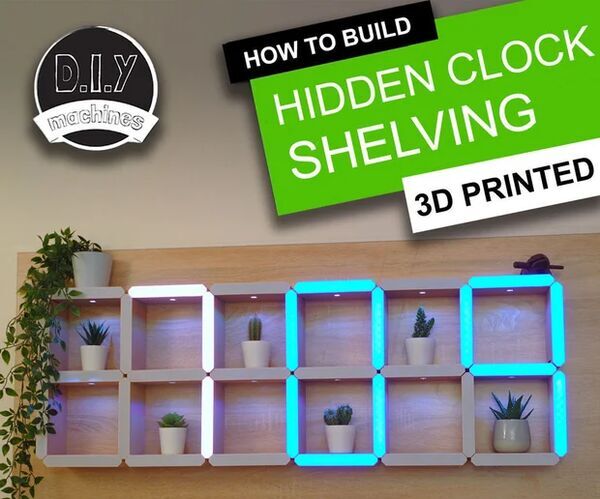
How to Build a Giant Hidden Shelf Edge Clock
"We had a large space on part of our living room wall for which we could never find the right 'thing' to hang on it. After trying for several years we decided to make something of our own. This turned out rather well (in our opinion) so I turned it into a project on my Youtube channel and a written Instructable which you're reading right now! It's a giant digital LED clock discreetly hidden in the edges of a geometric shelving system. It also included integrated LED downlighters to show off your favorite items on the shelves. As the lighting is LED (using WS2821B 'Neopixels') you can choose your own colours - both for the clock face and downlighters." [...]
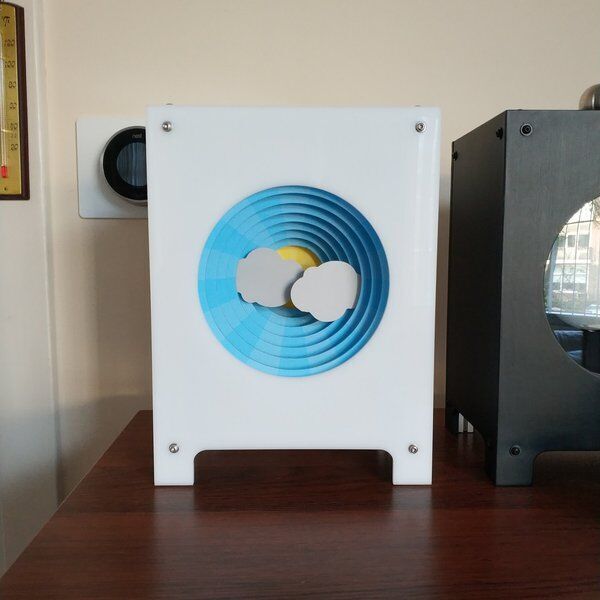
Tempestas II, A Clock style Barometer
"A Clock style barometer, that displays the current weather with different slides, driven by an arduino, 5 servos a PCA9685 and a bmp280. A Clock style barometer, that displays the current weather with different slides, driven by an Arduino Nano, 5 servos a PCA9685 and a bmp280. " [...]

Deep Eye - DeepStream Based Video Analytics Made Easy
"Hardware platform combined with DeepLib, an easy to use but yet powerful DeepStream based Python Library, and a web IDE In this project, I will showcase Deep Eye, a rapid prototyping platform for NVIDIA DeepStream based Video Analytics applications. The project consists in 3 maincomponents: a Hardware Platform that can be used with the Jeston Nano DeepLib, an easy to use Python Library, which allows creating DeepStream based video processing pipelines in an easy way a Web IDE that allows the easy creation of DeepStream based applications" [...]

Arduino Footswitch (control Your Guitar Amp With Arduino)
"So, you play music live, and you use metronome or click-tracks to synchronize your band. What if I told you that you can use that click-track to tell your amp to switch between channel by itself, in the exact time you need it, without you actually stomping on the footswitch? If you are like me, you try to put up the best show you can. But it's not as easy as it looks. You have to pay attention to a lot of things while playing; avoid mistakes in your playing/singing, remember the changes of the song, move around the stage, interact with the crowd, etc. Im not a trained musician, and though for most people all of this challenges can be overcome with practice and a lot of preparation; for me can be a bit overwhelming at times." [...]
That's all Folks!



